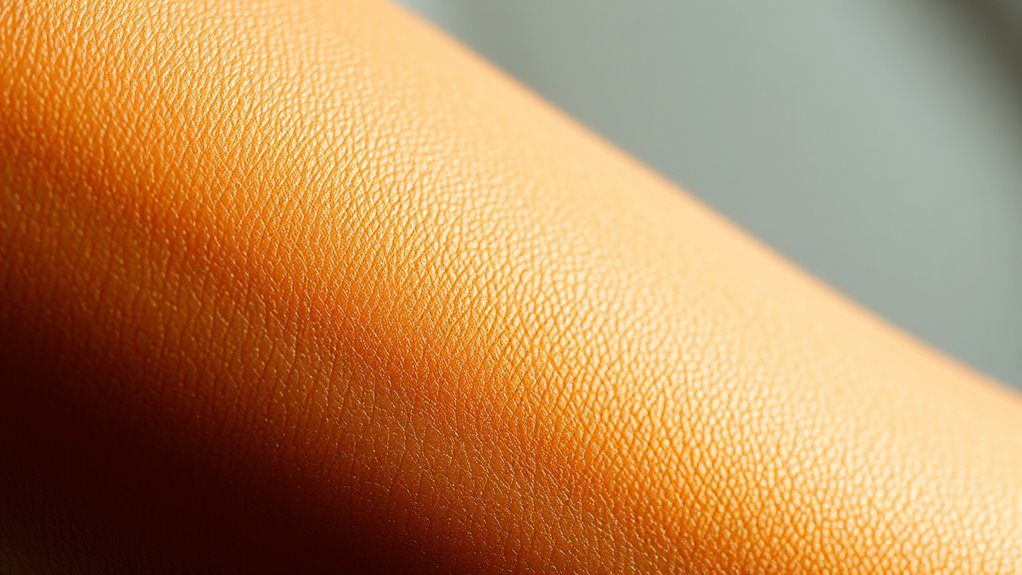When you’re exposed to sunlight, UVA and UVB rays trigger your skin’s melanocytes to produce melanin, the pigment that darkens your skin. UVA penetrates deep, causing aging signs, while UVB leads to sunburns and skin damage. The process involves complex molecular signals, like the alpha-MSH pathway, and is influenced by your genetics. Understanding how these factors work together can reveal how your skin colors itself—keep exploring to learn more.
Key Takeaways
- Melanocytes produce melanin, the pigment responsible for skin color, which is transferred to skin cells to create pigmentation.
- UV radiation stimulates melanin production through pathways like α-MSH-MCR1, leading to skin darkening or tanning.
- Eumelanin provides darker pigmentation and better UV protection, while pheomelanin results in red-yellow tones and less protection.
- Genetic factors, including specific gene variants, influence individual tanning ability and response to UV exposure.
- Tanning is a protective response that develops over days, with repeated UV exposure deepening and maintaining skin pigmentation.
How UVA and UVB Rays Affect Your Skin
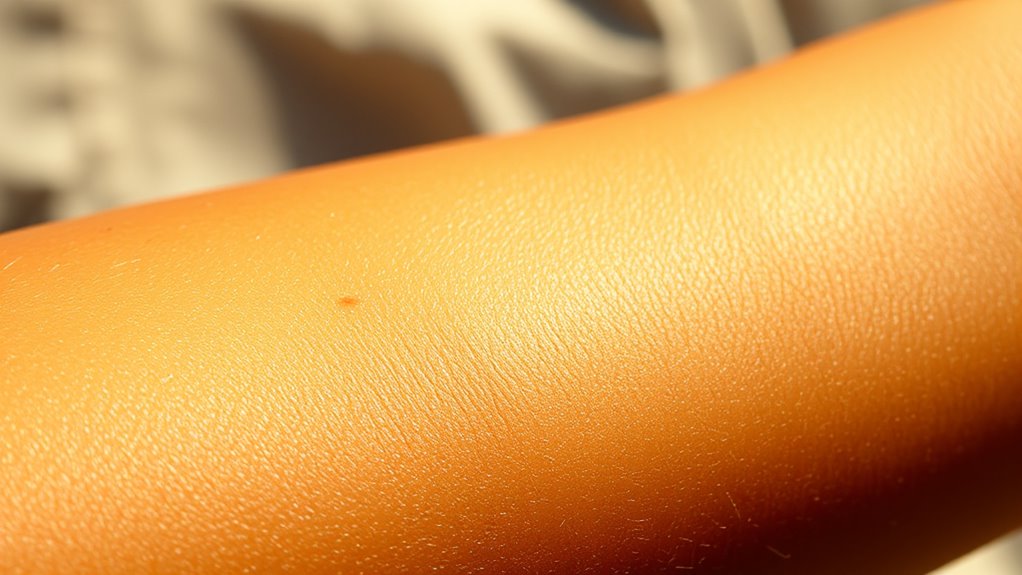
Have you ever wondered how UVA and UVB rays impact your skin? UVA rays penetrate deep, causing aging signs like wrinkles and inflammation. They damage collagen, making your skin less elastic, and can pass through glass, affecting you indoors. UVA exposure results in a tan, but it’s a sign of skin damage, not health. UVB rays mainly cause sunburns by inflaming and damaging skin cells. They trigger responses that lead to skin thickening and increase your risk for skin cancer. UVB also activates pathways like p53, helping repair DNA or causing cell death. Both types of rays alter your skin’s structure and function, with UVA promoting aging and UVB leading to mutations. Protecting yourself with sunscreen and clothing is essential to minimize these harmful effects. Understanding skin health can help you make better choices for safe sun exposure. Additionally, ongoing research highlights the importance of skin protection strategies in reducing long-term damage. Recognizing the different types of UV rays can further enhance your sun safety practices.
The Role of Melanocytes and Melanin Production
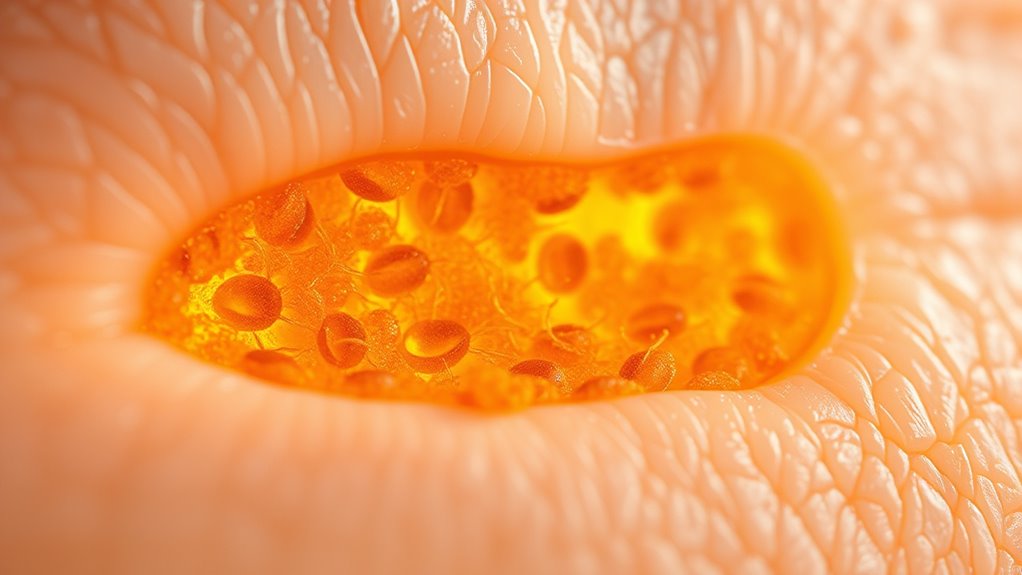
Melanocytes are specialized cells in your skin responsible for producing melanin, the pigment that gives your skin, hair, and eyes their color. These cells, originating from the neural crest, migrate to the basal epidermis, where they coexist with keratinocytes in organized units. Typically, there are about 1,000 to 2,000 melanocytes per square millimeter, making up around 5-10% of basal cells. They transfer melanin to keratinocytes via dendrites, forming a pigmented network. Melanin exists mainly as eumelanin (dark brown/black) and pheomelanin (red/yellow), synthesized inside melanosomes through oxidation of tyrosine. The type and amount of melanin produced determine your skin, hair, and eye color, and serve as a natural defense against UV damage.
The Molecular Pathways Behind Skin Darkening

Understanding how your skin darkens involves examining the molecular signaling pathways that regulate melanin production. The α-MSH-MCR1 pathway is key, stimulating melanogenesis to increase melanin synthesis. The SCF-KIT receptor activates a tyrosine kinase pathway, vital for melanocyte signaling and pigmentation. Inflammatory signals can also influence melanin levels, sometimes causing abnormal darkening. Genetics play a role, with mutations affecting these pathways and altering pigmentation. Enzymes like NNT, located in mitochondria, regulate melanin production and serve as protective responses against UV damage. Recent studies have shown that genetic variations can significantly impact individual responses to UV exposure and the resulting skin darkening. Enhancing or inhibiting these pathways can modify skin color, with topical treatments targeting enzymes like NNT to boost melanin. Additionally, vertical storage solutions can be used to organize skincare products and tools efficiently in a home setting. Moreover, understanding the molecular mechanisms involved can lead to more targeted and effective skin treatments. Overall, these molecular pathways coordinate to control how your skin responds to UV exposure and other environmental cues.
Timing and Changes in the Tanning Process

The process of your skin darkening doesn’t happen instantly; instead, it takes time for visible changes to appear after UV exposure. Typically, you’ll notice a tan around 72 hours later, as your skin produces more melanin. Skin type plays a big role—fairer skin tends to take longer to develop a tan, while darker skin may tan more quickly. Regular exposure helps deepen and maintain the color faster, as your skin adapts to UV rays. For first-time tanners, it usually takes 5-7 sessions to see noticeable results, whereas experienced tanners need fewer. Environmental factors like cloud cover or the time of day also influence how quickly your skin tans. Overall, patience and consistent exposure are key to achieving and maintaining a healthy-looking tan. Monitoring your skin’s response can help prevent overexposure and ensure healthy tanning progress. Additionally, understanding the role of melanin in skin coloration can guide safer tanning practices, especially as recent advances in skin science shed light on individual differences in tanning response. Incorporating personalized tanning strategies based on your skin type and response can further optimize results. Being aware of how air quality might affect skin health and recovery can further enhance your tanning routine.
Chemical Agents That Stimulate Melanin Production
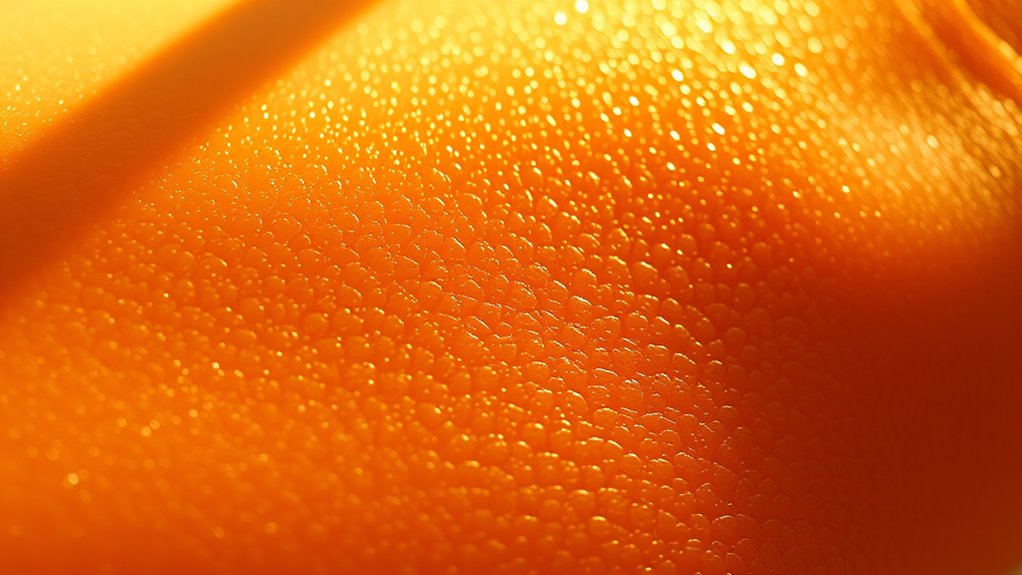
Chemical agents that stimulate melanin production play an essential role in the tanning process by actively triggering the pathways that increase melanin synthesis. When exposed to UV radiation, your skin boosts levels of pro-opiomelanocortin (POMC), which is cleaved into α-melanocyte-stimulating hormone (α-MSH). This hormone binds to the MC1R receptor on melanocytes, activating intracellular signals that boost melanin production. Agents like α-MSH, stem cell factor (SCF), and vasoactive intestinal peptide (VIP) directly promote melanogenesis by enhancing enzyme activity and gene expression. Tyrosine and phenylalanine serve as substrates in this process. Additionally, the activation of these pathways is influenced by genetic variation, which can affect individual responses to tanning agents. Moreover, research indicates that chemical signaling pathways can be modulated to optimize melanin production for cosmetic or therapeutic purposes. These pathways can also be influenced by external factors, making individual responses highly variable. Conversely, compounds like agouti signaling protein (ASP) and melanocyte-inhibiting factors suppress melanin synthesis by blocking α-MSH or interfering with melanogenic pathways. These chemical agents collectively regulate your skin’s pigmentation response. Additionally, fitness center hours can influence how effectively your routine supports skin health, as regular exercise improves circulation and skin vitality.
The Biological Significance and Risks of Tanning
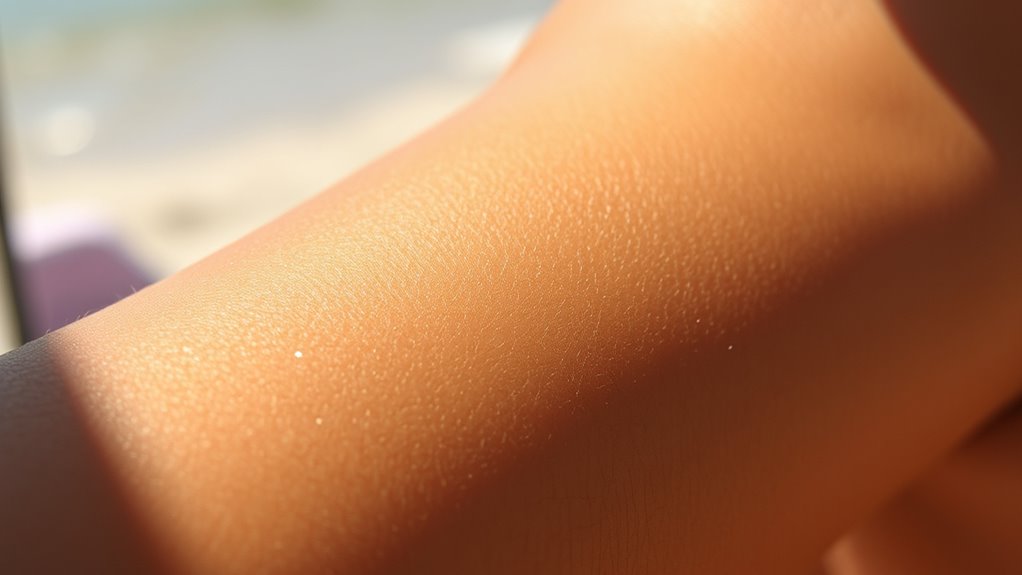
Tanning triggers essential biological processes in your skin, primarily through the production of melanin, which acts as a natural defense against UV damage. This response evolved about a million years ago to protect skin cells from DNA mutations caused by sunlight. Melanin absorbs and dissipates UV radiation, serving as a physical barrier to prevent deeper skin damage. Beyond pigmentation, melanin and its intermediates neutralize free radicals and reduce oxidative stress from UV exposure. While tanning offers some protective benefits, it signals prior damage and increases mutation risks, raising concerns about skin cancer. Both UVA and UVB rays contribute to damage—UVA causes premature aging, and UVB leads to sunburn and DNA injury. Overall, tanning is a biological defense that still carries significant health risks.
Genetic Factors Influencing Tanning Ability
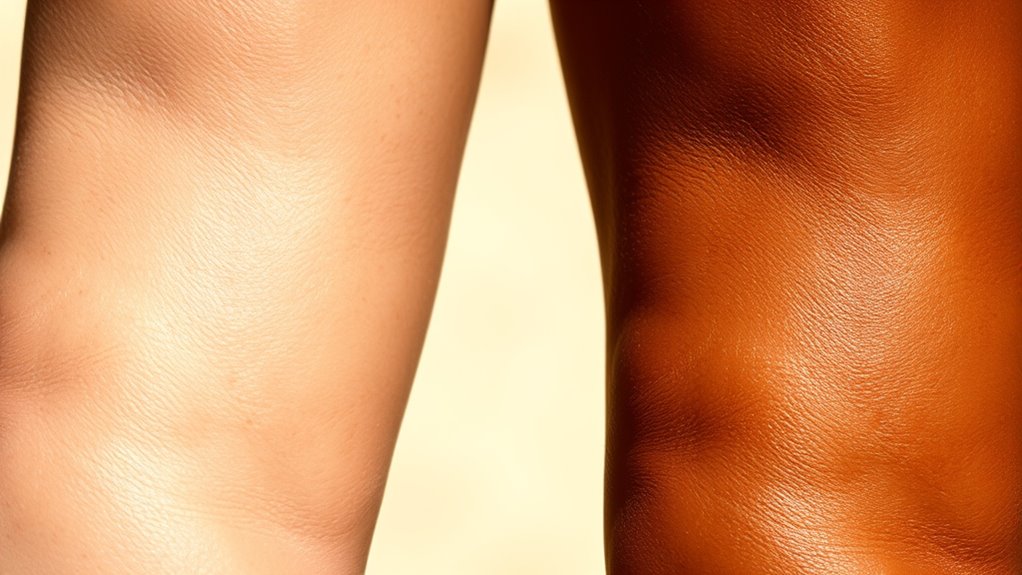
Your skin’s response to UV exposure isn’t solely shaped by environmental factors—it’s heavily influenced by your genetics. Recent studies identify specific genetic variants that determine how easily your skin tans. For example, the *EXOC2* gene, especially the SNP rs12210050 T allele, is linked to increased tanning ability but also higher skin cancer risk. Variants at the *AGR3/AHR* locus influence both tanning response and melanoma susceptibility, indicating shared genetic pathways. Genes like *TYR* and *IRF4* regulate melanin production and distribution, directly affecting your skin’s pigmentation and reaction to UV. Additionally, genetic differences in melanin type—eumelanin versus pheomelanin—impact tanning efficacy and susceptibility to burns. These genetic factors explain why some people tan easily, while others burn or struggle to develop a tan, influencing both appearance and health risks.
Future Approaches to Safer Skin Tanning

As awareness of the health risks associated with indoor tanning grows, developing safer strategies becomes increasingly important. Public health initiatives and regulations are key in limiting access, especially for minors, reducing exposure to harmful UVA and UVB rays. Education campaigns can dispel myths and inform people about safer alternatives like self-tanning products, which use FDA-approved DHA to mimic a tan without UV exposure. Advances in behavioral research and interventions, such as exploring the use of opioid antagonists like Naltrexone, aim to reduce the psychological drive to tan. Additionally, new technologies, including tan-activating formulations combined with high SPF sunscreens, encourage safer sun exposure practices. Collaboration across healthcare, government, and community sectors will be essential in promoting these safer approaches and decreasing skin cancer risks. Moreover, understanding how personality traits can foster innovative solutions may inspire new approaches to public health challenges related to tanning. Recognizing the importance of merchant services in supporting health initiatives, such as funding public awareness campaigns, can enhance the reach and effectiveness of these programs. Incorporating behavioral interventions that address individual motivations may further improve adherence to safer tanning behaviors.
Frequently Asked Questions
Can You Tan Through Clothing or Only Exposed Skin?
You can tan through clothing, especially if the fabric is thin, loose, or has a low UPF rating. Light or mesh fabrics allow more UV rays to reach your skin, increasing tanning potential. Tightly woven, darker, or thicker fabrics block more UV, reducing tanning chances. For better protection, wear UPF-rated clothing, but if your goal is to tan, expose more skin and choose fabrics that let UV through.
Does Tanning Provide Complete Protection Against Uv-Induced Skin Damage?
Imagine your skin as a battlefield, fighting UV rays with every tan. But no matter how deep your tan appears, it doesn’t fully shield you. Tanning provides only limited protection, with SPF between 2 and 4, far below recommended levels. UV rays still penetrate, causing damage that can lead to premature aging and skin cancer. So, relying solely on a tan leaves you exposed—protect with sunscreen and clothing for true safety.
How Does Age Affect the Skin’S Ability to Tan?
As you age, your skin’s ability to tan declines because you lose about 10-20% of melanocytes each decade, reducing melanin production. Thinner, less elastic skin allows more UV penetration and hampers your skin’s response to UV exposure. Additionally, diminished immune function and slower repair processes mean your skin can’t recover or adapt as effectively, making tanning less prominent and increasing your risk for UV damage and skin aging over time.
Are There Natural Foods That Enhance Melanin Production?
Ever wondered if certain foods can boost your skin’s melanin? You bet! Foods rich in copper like dark chocolate, shellfish, and lentils support melanin production by activating the enzyme tyrosinase. Antioxidant-packed options such as blueberries and leafy greens protect skin cells and promote pigmentation. Carrots, sweet potatoes, and spinach provide vitamin A, essential for healthy melanin synthesis. Including these in your diet naturally enhances your skin’s pigmentation and overall health.
Can Tanning Be Achieved Without Any UV Exposure at All?
Yes, you can achieve a tan without UV exposure by using sunless tanning products or spray tans. These options contain dihydroxyacetone (DHA), which reacts with your skin’s surface to create a temporary bronzed look. They’re safe, quick, and customizable, giving you a natural-looking glow without the risks of sunbathing or tanning beds. Just remember, these tans fade over time and don’t offer UV protection.
Conclusion
Now that you understand how your skin transforms under the sun’s touch, you can appreciate its intricate dance of biology and beauty. Every flicker of melanin shields you, like a delicate armor woven from nature’s own threads. But remember, this radiant glow comes with risks. Embrace safety, respect your skin’s signals, and let the warmth of the sun remind you of its powerful, yet fragile, artistry—your body’s own masterpiece of resilience.
